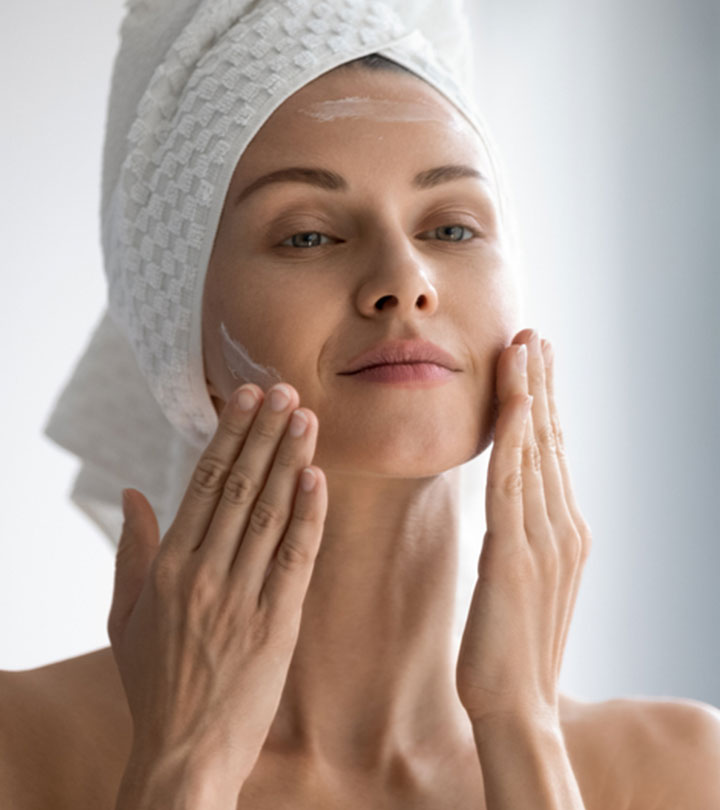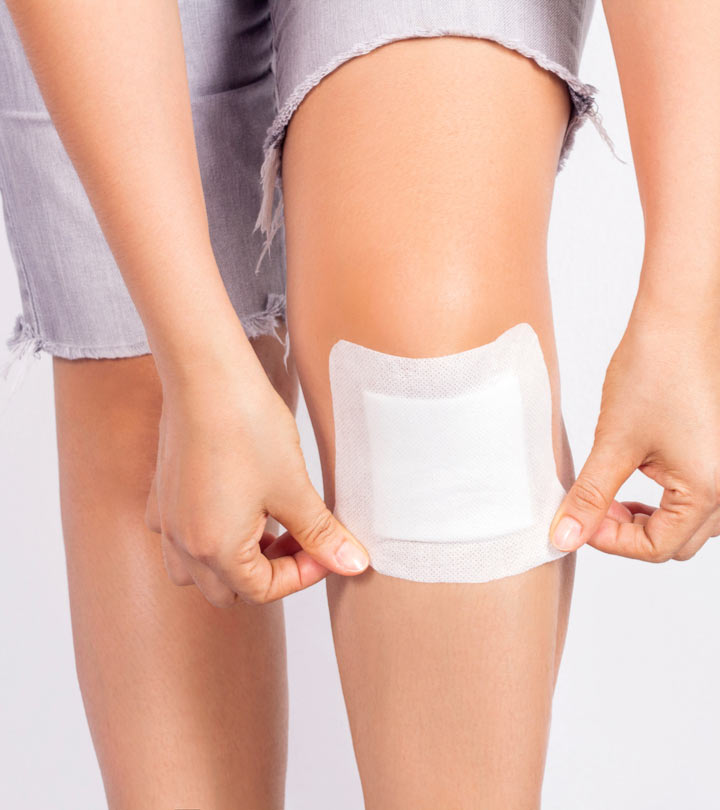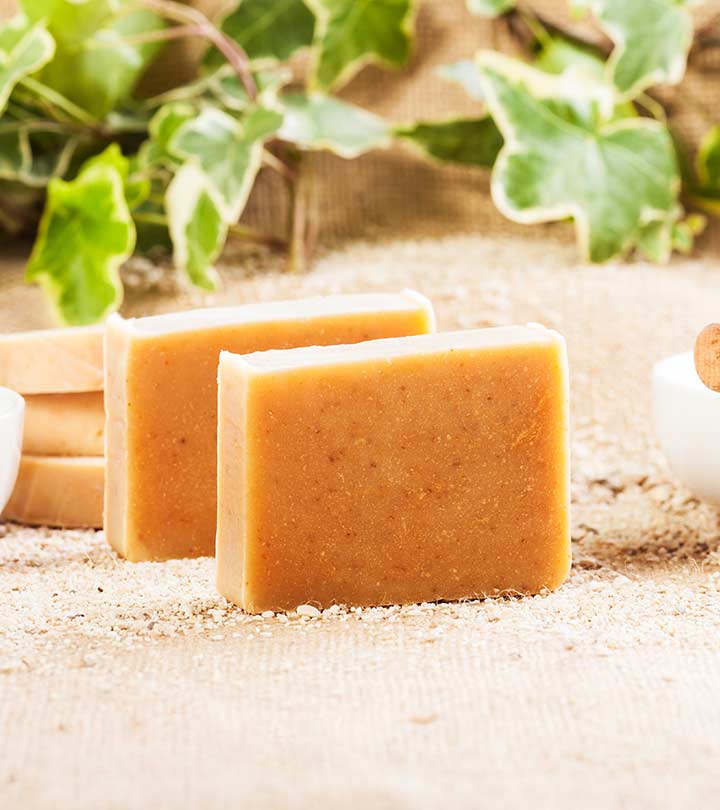Azelaic acid is a powerful antioxidant that may resolve many skincare woes. You can also use azelaic acid for skin tone correction, reducing skin blemishes, discolorations, and improving skin texture. It also suits almost all skin types.
It is often used in skin care formulations. If your skin breaks out easily and has issues like scarring and pigmentation, you may consider using azelaic acid. It also helps minimize skin sensitivity.
This article delves into the benefits of azelaic acid, how to use it on your skin, and side effects. Keep reading to know more.
In This Article
What Is Azelaic Acid?
Shutterstock
Azelaic acid is chemically composed of dicarboxylic acid. It is produced naturally on your skin by a type of yeast called Malassezia furfur (1). But you can also synthesize it in a laboratory using grains and cereals such as barley, wheat, and rye. The lab-engineered form is useful in skin care products due to its stable and beneficial properties.
Most of the formulations for topical azelaic acid vary between 15 to 20 percent concentrations. While it is available in lower concentrations too, using it in combination with other ingredients is much more efficient than when used alone.
Are you wondering how you can incorporate azelaic acid into your skincare routine? Read to know.
How To Use Azelaic Acid
Shutterstock
Azelaic acid is available in gel, foam, and cream forms. These different forms help ease the application process when used on various areas of your body.
The foam version is more suitable if you need to cover a large area of your skin, such as your back. An azelaic acid cream or gel would suffice to cover smaller areas, like your face.
Here is how you can use azelaic acid on your skin:
- Cleanse your face thoroughly to allow your skin to absorb the product.
- Consider applying an AHA (like glycolic or lactic acid), BHA, or retinol first. It will help open up your skin and readily accept azelaic acid.
- Apply a thin layer of azelaic acid to dry skin twice a day.
- Follow up with a hydrating moisturizer. In the mornings, you can apply sunscreen with SPF 30 after using azelaic acid.
For sensitive skin, experts recommend using azelaic acid only once a day. Use a pea-sized amount while applying it to a smaller area (like your face or neck).
Azelex and Finacea are two popular brands of topical azelaic acid. These products contain about 15 percent concentration of azelaic acid.
Azelaic acid may tackle breakouts, inflammation, uneven and darker skin tone, among other skin concerns. Learn about the benefits of this multifunctional skincare ingredient below.
What Are The Benefits Of Using Azelaic Acid?
Shutterstock
1. Offers Gentle Exfoliation
If you have congested skin or clogged pores, you can use azelaic acid as an exfoliant. Upon application, the ingredient penetrates the pores and helps remove any impurities. It exfoliates the superficial dead skin cells that cause an uneven, dull skin tone. More research is warranted to further understand the exfoliating action of azelaic acid.
Related: 20 Home Remedies To Get Rid Of Open Pores On Skin
2. May Reduce Acne
Azelaic acid has anti-inflammatory and anti-bacterial properties that can control acne lesions (2). Research demonstrates its bactericidal role against P. acne, a common cause of breakouts (3). Azelaic acid may also be used on sensitive skin as it soothes any irritation on the face. It also may improve general redness caused by inflammation.
Related: 13 Tips And Remedies To Prevent Acne And Pimples Naturally
3. May Even Out Skin Tone
Azelaic acid may help even out your skin tone as it inhibits enzymes linked to hyperpigmentation. It can reduce any discolorations or dark spots in your complexion due to acne breakouts. It also may help treat melasma (4), (5).
Related: Uneven Skin Tone: Treatments, Home Remedies, & Tips To Manage
4. May Help Treat Rosacea
If your face is prone to red patches and irritation due to rosacea, azelaic acid may offer some benefit. The active ingredient reduces inflammation and fights against secondary infection in rosacea (6). Plus, an azelaic acid gel is gentle enough to be used on sensitive skin and may also improve your overall skin tone.
Related: 10 Home Remedies For Rosacea That Prevent Redness On The Skin
5. Could Be Safe For Use In Pregnancy
Azelaic acid may safely manage acne, rosacea, and pigmentations during pregnancy (7). Nevertheless, it is always best to speak to a dermatologist before using this ingredient during this period.
The comedolytici XThe ability to prevent comedones, open and closed skin pores (blackheads and whiteheads) that form due to dead skin cells and bacteria. , anti-inflammatory, and exfoliating properties of azelaic acid are making it popular among skincare enthusiasts as an anti-acne treatment. But how does this active ingredient help fight acne? Find out more below.
How Does Azelaic Acid Fight Acne?
Shutterstock
Azelaic acid works as a useful acne treatment by inhibiting certain enzymes. These enzymes influence the chemical activity within the superficial layer of your skin. This enzymatic inhibition prevents the DNA synthesis of the acne-causing bacteria (8).
The antibacterial properties of azelaic acid may combat acne eruptions and prevent a recurrence (3). The ingredient is thought to encourage cell turnover and potentially help reduce acne scars and dark spots. Cell turnover is the process of shedding old layers of your skin and replacing them with new, healthy layers. Enhanced cell turnover rate may help the skin renew itself faster.
StyleCraze SaysAzelaic acid does not penetrate deep into the skin. Therefore it is a poor ingredient in treating deep and severe cystic acnei XPainful, pus-filled pimples that form deep under the skin due to the accumulation of oil and dead skin over the hair follicles. .
How Does Azelaic Acid Compare With Other Treatments?
Subscribe
Azelaic acid can exfoliate the skin. However, unlike the other acids (alpha hydroxy acid, glycolic acid, and salicylic acid), azelaic acid is not strong enough as a chemical peel.
Skincare products with azelaic acid require more time to take effect and are less likely to irritate your skin. Due to its slow action, azelaic acid works best in combination with other forms of acne treatment. If used in combination, it may address multiple skin issues, including age-related skin concerns and stubborn acne. Consult your doctor for more information in this regard.
StyleCraze SaysAzelaic acid is your safe bet if other active ingredients, like retinol, salicylic acid, benzoyl peroxide, etc., don’t work for you. Also, it is compatible with most ingredients.
Azelaic acid offers several skin benefits. But is it safe to be included in your skincare routine?
Can You Use Azelaic Acid Every Day?
Yes, azelaic acid can be safely used daily. The products are generally non-toxic and well-tolerated by most. However, if you have extremely dry, sensitive, or acne-prone skin, use this treatment on alternate days. Once your skin has gotten used to azelaic acid, you can slowly increase the frequency of application.
For advanced skin conditions, it is best to consult a dermatologist. They can guide you better in choosing the right treatment for you.
Although azelaic acid can benefit your skin in many ways, it may have certain adverse effects. Read on to know more.
Azelaic Acid: Side Effects And Precautions
Shutterstock
People with sensitive skin or eczemai XA common skin condition that causes itchiness and inflammation due to stress or exposure to an allergen. may experience irritation on applying azelaic acid to their face. Some other side effects of using azelaic acid on your skin include:
- Slight burning or tingling sensations (9)
- Skin flaking or peeling at the applied area
- Dry, itchy skin
- Redness and swelling
Anecdotal evidence suggests that azelaic acid may also cause breathing difficulties, fever, joint aches, and tightness of the chest. However, these side effects are very rare.
If you experience any side effects, stop using the product and seek medical assistance. You can perform a patch test before using the products to determine if you are sensitive to them.
When you apply azelaic acid, remember to follow up with a moisturizer and sunscreen. The ingredient strips the superficial layer of your skin and may make it vulnerable to environmental damage. Also, avoid using astringents and strong cleansers when you use azelaic acid skincare products.
Takeaway
If your skin is prone to scarring and breakouts, azelaic acid is one of the perfect ways to tackle them. Azelaic acid’s stable and beneficial properties help resolve many skin care woes, including blemishes, uneven skin tone, discolorations, and texture. You may use azelaic acid available as a gel, foam, or cream. The several benefits of this ingredient include exfoliation, acne management, and rosacea treatment. Though azelaic acid is safe for daily use, you may use it on alternate days if you have extremely sensitive or dry skin. Consult your doctor if you experience any side effects.
















